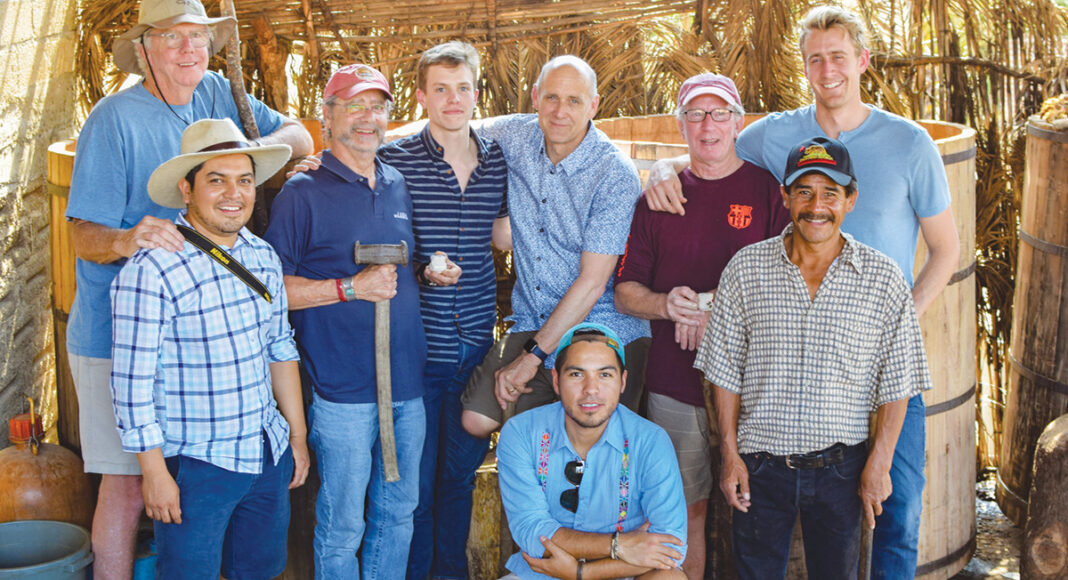The word mezcal whispers of sensory magic. A cousin of tequila—and yet so different—this potent, double-distilled elixir made from the mighty agave succulent can thrill the senses, take the breath away and, if sipped properly, unleash haunting dreams.
So what better way to greet the new year than with a new hand-crafted mezcal, Huxal, produced by an alliance of Oaxaqueño artisans and local entrepreneurs? The seasoned skill of mescalero Don Bernardo and three generations of family artisans in the Mexican state of Oaxaca (a second home to many Santa Cruzans) combine to make Huxal mezcals. Huxal’s import team is led by Aptos residents David Camner and Sam Hernandez, sculptor and emeritus from Santa Clara University, along with their Palo Alto colleagues.
“It started with some local arts guys, family and friends going to Oaxaca, with whom Palo Alto has a sister city connection,” recalls glass blower Camner. “The idea was to support sending fire-fighting equipment to Oaxaca.” After a three-year search, the Huxal team found the ideal producers in the southern valleys of Oaxaca near Miahuatlan. “We were looking for consistent quality and sustainability,” Camner says. “And they had a nice clean palenque (mezcal distillery). It was ideal.” Camner and Hernandez met me at the cozy, boisterous Parish Publick House and brought along the Huxal product line for me to taste—four bottles of distinctive spirits, plus a jar of those famed Oaxaqueno fried crickets, or chapulines.
We started with Espadin, 40% alcohol, light, easy to like, and made from roasted and fermented agave hearts harvested at seven years of maturity.
Briefly, the making of artisanal mezcal involves harvesting the heart of the huge plant, roasting it in an underground stone oven, crushing it with an ox-pulled stone, then double-distilling in copper. The Espadin was smooth, Earthy and satisfying. I taste, rub some on my palms to release aromas, and sample the mezcal along with some sal de gusano—made of spices, crushed worm (hey, it’s traditional) and salt. Espadin’s middle bandwidth expands horizontally on my palate. Like each Huxal bottle, this one comes with a playful label by Hernandez, and it’s named for the variety of its source agave.
The bravura Barreno (100 proof), made from wild plants from the hills surrounding the Miahuatlán palenque, is the rarest. Hernandez opens a jar of small-batch prickly pear jelly. We sample it on Parish house bread chased by a sip of the complex Barreno. The terroir of the Oaxacan highlands, at 5,500-feet elevation, fills this beautifully balanced organic mezcal, intense with minerals, leather and that smoke signature from its fire roasted origins.
Completing the Huxal quartet are two mezcals made from the karwinskii agave.
The aromatic Cuishe is grassy, floral and fresh. The heftier Madrecuishe is more rounded and deeper in smokiness with a licorice heart. Both are close to 100-proof alcohol. “This is a primitive process,” Camner says with a smile. But the result is refined. The flavors are lavish, yet as elusive as a dream.
“It’s a multi-generational effort,” Hernandez explains. “We’re starting small, for pleasure and the aesthetics of it. And now our own families are involved.” While focusing on small-batch techniques, Huxal is now helping the producers and their families stay working in their small villages. Camner characterizes the ancient craft fueling the Huxal enterprise: “Artisanal, low-tech. Pure spirits.” A portion of every Huxal purchase brings decommissioned fire trucks and ambulances from California to Oaxaca, where the organic agave spirits are created by maestro Don Bernardo. It also makes for a distinctive holiday gift! Bottles available at Deer Park Liquors and Shoppers Corner ($80-100). At the bar at Parish Publick House and Palapas.













